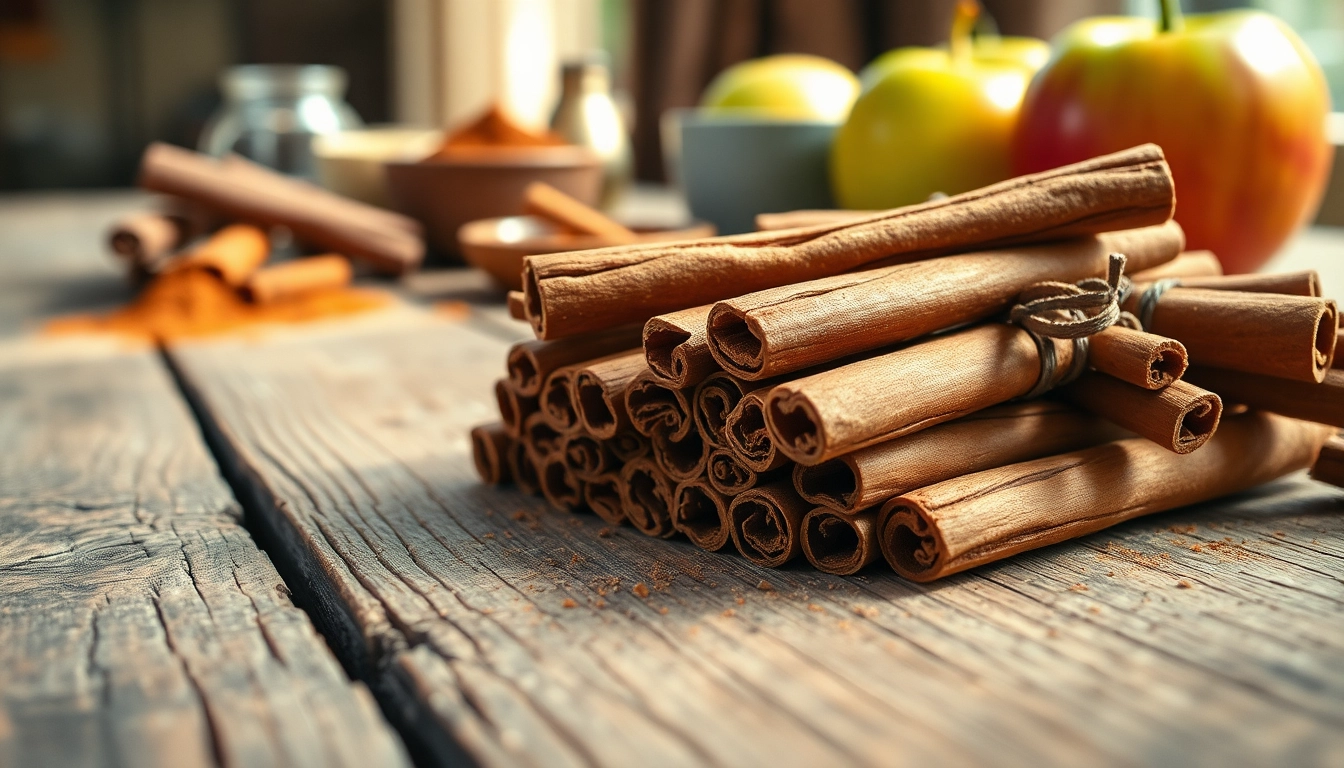
Understanding Cinnamon Bark: Types and Characteristics
What is Cinnamon Bark?
Cinnamon bark is a spice derived from the inner bark of trees belonging to the genus Cinnamomum. It has been a favored ingredient in cooking and traditional medicine for centuries due to its unique flavor and aroma. The bark is harvested from young stems, which are stripped of their outer bark, allowing the inner bark to dry and curl into quills. These quills are often ground into powder for various culinary applications.
Considered a staple in kitchens around the world, cinnamon bark not only enhances the flavor of dishes but also offers numerous health benefits. It’s available mainly in two varieties: Ceylon and Cassia, each with distinct characteristics.
Varieties: Ceylon vs. Cassia Cinnamon Bark
Among the different types of cinnamon, Ceylon (known as “true” cinnamon) and Cassia are the most prevalent. Each type possesses unique properties that cater to specific culinary and health needs.
- Ceylon Cinnamon: Ceylon cinnamon is typically sweeter and has a delicate, complex flavor profile. It contains lower levels of coumarin, a compound that can be harmful in large quantities. Ceylon is often prized for its culinary versatility and medicinal applications.
- Cassia Cinnamon: Cassia is the more common variety and is often found in grocery stores. Its rich, spicy flavor makes it ideal for desserts and robust dishes. However, it contains higher levels of coumarin, which may be concerning for regular consumption, especially in large amounts.
Recognizing Quality in Cinnamon Bark
Identifying quality cinnamon is essential for both culinary applications and health benefits. Look for the following indicators:
- Color: High-quality Ceylon cinnamon is light brown, while Cassia tends to be darker.
- Smell: True cinnamon has a fragrant aroma that is sweeter and more complex than that of Cassia.
- Form: Whole quills are generally of better quality, retaining flavor longer compared to ground cinnamon, which can lose potency quickly.
Culinary Uses of Cinnamon Bark
Incorporating Cinnamon Bark in Cooking and Baking
Cinnamon bark is incredibly versatile in cooking and baking, elevating both savory and sweet dishes. Here are some common ways to incorporate it:
- Ground Cinnamon: Often used in baking recipes, such as cinnamon rolls, cookies, and cakes. Adding a pinch to oatmeal or yogurt can enhance flavors.
- Cinnamon Sticks: These are excellent for infusing flavor into soups, stews, and sauces. Simply simmer a stick in the dish while cooking for an aromatic touch.
Traditional Dishes Featuring Cinnamon Bark
Many cultures have traditional dishes that prominently feature cinnamon bark:
- Mexican Hot Chocolate: Rich, spiced chocolate beverage enhanced with cinnamon for a unique zesty flavor.
- Indian Biryani: A fragrant rice dish that often includes cinnamon sticks among other spices, creating an intricate flavor profile.
Innovative Recipes with Cinnamon Bark
Beyond traditional uses, innovative recipes are emerging that highlight cinnamon bark’s unique characteristics:
- Infused Oils: Create flavored oils by steeping cinnamon sticks in olive oil, ideal for dressings or dips.
- Chai Tea: A warming blend of spices and tea, with cinnamon bark being a crucial ingredient that adds depth and flavor.
Health Benefits of Cinnamon Bark
Nutritional Profile of Cinnamon Bark
Cinnamon bark is not just flavorful; it packs a nutritional punch. It is rich in antioxidants, vitamins, and minerals:
- Antioxidants: Loaded with powerful antioxidants like polyphenols that combat oxidative stress.
- Vitamins: Contains small amounts of vitamin K and calcium, contributing to various bodily functions.
Medicinal Uses and Therapeutic Properties
Cinnamon bark has been shown to have various health benefits, including:
- Anti-Inflammatory Effects: Natural compounds in cinnamon can help reduce inflammation, which is beneficial for overall health.
- Aiding Digestion: Traditionally used to alleviate digestive issues such as bloating, gas, and indigestion.
- Blood Sugar Regulation: Cinnamon can improve insulin sensitivity and lower blood sugar levels, making it beneficial for people with diabetes.
How Cinnamon Bark Supports Metabolic Health
Numerous studies suggest that cinnamon bark can play a crucial role in metabolic health. For instance, research has indicated that the presence of cinnamon in the diet can lead to improved blood glucose levels and lipid profiles, potentially reducing the risk of heart disease. Regular consumption of cinnamon bark can thus be part of a heart-healthy diet.
Potential Side Effects and Considerations
Understanding Safe Consumption Levels of Cinnamon Bark
While cinnamon bark is beneficial, it’s essential to consume it in moderation. Excessive intake, particularly of Cassia cinnamon, can lead to toxicity due to high coumarin levels. The acceptable daily intake is generally considered to be around 0.05 mg per kg body weight.
Possible Interactions and Contraindications
Cinnamon bark can interact with certain medications and may not be suitable for everyone. Some potential interactions include:
- Blood Thinners: Cinnamon might enhance the effects of blood-thinning medications.
- Diabetes Medications: Those on insulin or other diabetes meds should monitor blood sugar levels closely when increasing cinnamon consumption.
When to Consult a Healthcare Provider Regarding Cinnamon Bark
If you have underlying health conditions or are taking medications, it’s advisable to consult a healthcare provider before adding cinnamon bark to your regimen. They can guide you regarding appropriate dosage and potential interactions.
Sustainable Sourcing and Environmental Impact of Cinnamon Bark
The Importance of Ethical Sourcing
Sustainable and ethical sourcing of cinnamon is crucial for preserving the environment and supporting local farmers. Selecting sustainably harvested cinnamon helps promote biodiversity and prevents deforestation.
Environmental Benefits of Sustainable Cinnamon Bark Production
When cinnamon is produced sustainably, it has several environmental benefits:
- Biodiversity Preservation: Sustainable practices encourage the maintenance of diverse ecosystems that support various plant and animal species.
- Carbon Footprint Reduction: Sustainable farming often requires less chemical inputs and may involve agroforestry systems that capture carbon more effectively.
How to Choose Eco-Friendly Cinnamon Bark Products
When purchasing cinnamon bark, consider the following tips to ensure you’re choosing eco-friendly options:
- Look for Certifications: Certifications from recognized organizations can indicate sustainable practices.
- Research Brands: Understand the sourcing practices of brands and prioritize those that promote environmental stewardship.
- Buy Whole Quills: Whole cinnamon quills often have a longer shelf life and retain flavor more effectively than pre-ground options.







